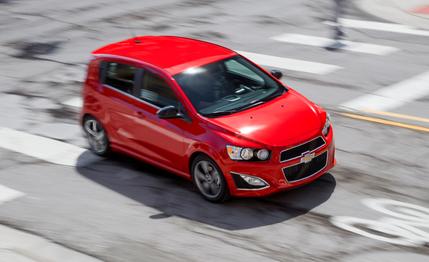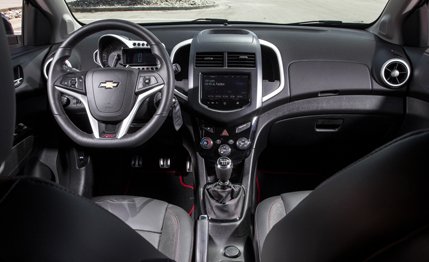 Instrumented Test
Instrumented Test
After years of diluting its fabled SS badge, Chevrolet has sworn off applying it to models that are unworthy and unfun. But hold the applause, as there’s another letter sequence that wears the double-sided sticky tape: RS. This less-fondly remembered moniker, which is “a throwback to ‘Rally Sport,’ ” according to a Chevy spokeswoman, now goes on bow-tie-brand cosmetology projects. After driving the new-for-2013 Sonic RS, however, we’d suggest that RS stands for “Rather Subtle.” Or, perhaps, “Regular Sonic.”
It does not mean more power for the turbocharged, 1.4-liter four-cylinder, which still makes 138 horses. It does not denote stickier tires on larger wheels, as the same all-season, 17-inch Hankook Optimos offered in LTZ trim also appear here. Indeed, the $20,995 Sonic RS is not so much a special model as it is a few nice upgrades in one package atop the five-door range. Leather seats, four-wheel disc brakes, and a close-ratio six-speed manual transmission lead the list of new and exclusive equipment that justifies a $1635 upcharge from the turbo LTZ. Aluminum pedals, a shiny exhaust tip, and some exterior styling changes are there for people who like jewel-encrusted cellphone covers.

As with the Camaro and Cruze (the only other Chevys offered with an RS appearance package), the Sonic looks better as an RS than it does in lesser trims. From its diamond-shaped fog lamps to its chamfered rear spoiler, the RS is outwardly aggressive. Inside, its comfortable and supportive seats are trimmed in high-quality leather and sueded microfiber with contrasting red stitching. Even if the underlying parts—including the out-of-place fold-down armrest—are the same as in other Sonics, getting these seats in this car is like finding Gucci loafers at T.J.Maxx.

The RS is fun to drive in that slow-car-fast kind of way, with plenty of gear-rowing to keep you engaged. To wit: It takes two shifts and 8.1 seconds to get to 60 mph, a tenth quicker than the last turbo Sonic we tested thanks to a shorter final drive (4.18:1 versus 3.65:1). While there is an optional six-speed automatic, we didn’t drive it, and if you are reading this magazine, neither should you. Braking performance is also improved in the RS, with stopping distance from 70 mph shrinking from 171 feet to 163, though the pedal still has too much initial softness.
Suspension changes, including a 0.4-inch-lower ride height and springs stiffened by 20 percent, give the RS more grip but proved less gripping in the real world. While we managed 0.84 g on the skidpad, up from 0.82, this Sonic still understeers plenty and begins pushing before it should. Its electrically assisted power steering has additional weight, though the heft feels artificial and doesn’t sharpen feedback.
The regular Sonic is a good car, so it’s not surprising that the Sonic RS is, too. But we can’t help wishing that GM had put more distance between them. The RS costs only $1200 less than the 197-hp Ford Fiesta ST. What’s missing in the Sonic is the gobsmacked feeling you get from a light, powerful car like the ST, which announces itself the minute you turn the key and reminds you why you bought it at every corner exit. Should such a Sonic ever happen, at least Chevy has the right badge waiting for it.